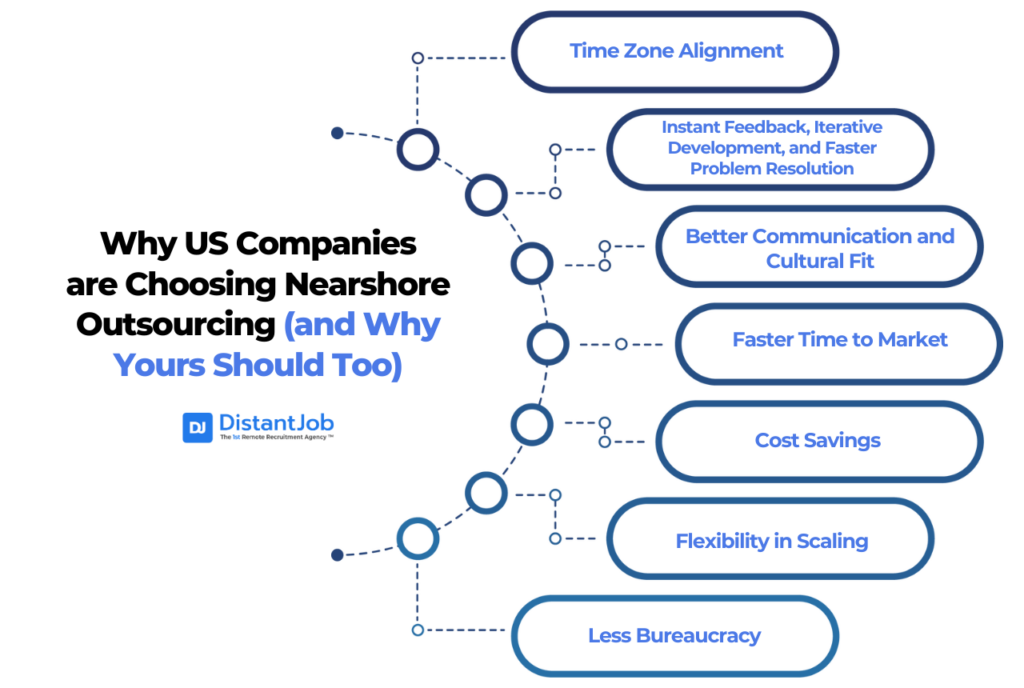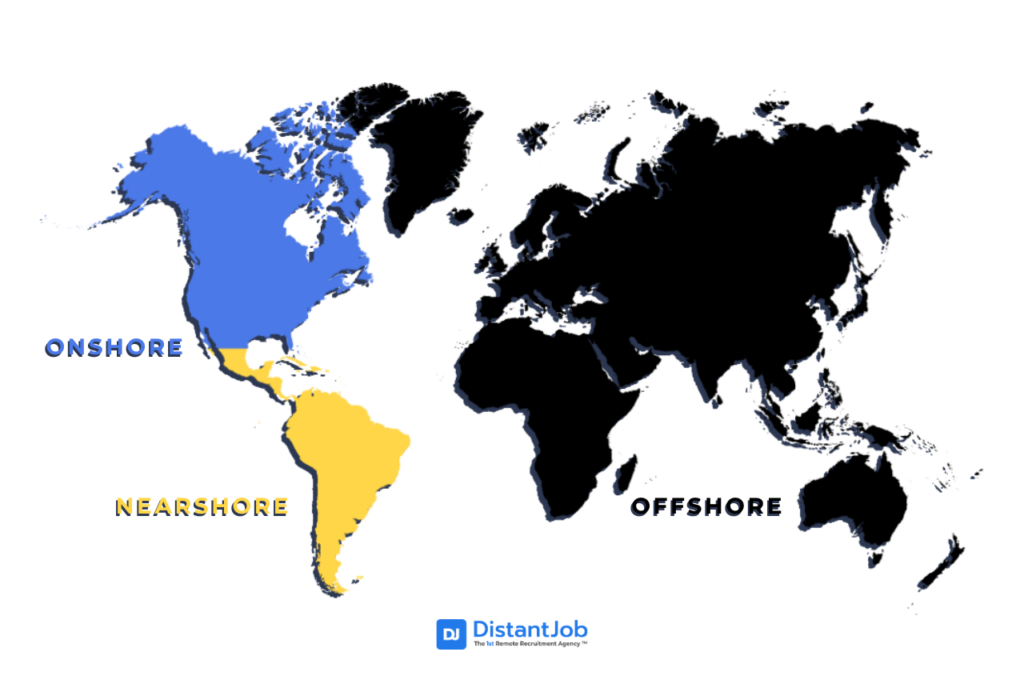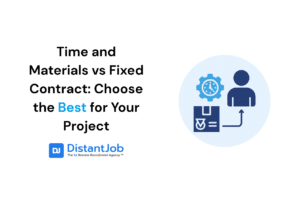Nearshore software development is a tactic businesses everywhere use in order to hire great talent at lower costs from countries in the same or similar time zone as their own. For US companies, this means partnering with nearshore providers and hiring developers from Latin American countries such as Mexico, Colombia, Argentina, Brazil, or Costa Rica.
The benefits of nearshoring are many. It is 46 percent cheaper than onshore staffing (good news for North American companies, 80 percent of which work with nearshore company partners). Because the countries are closer, they often share a timezone, and there can be a greater cultural fit. (Countries that are geographically closer to each other often have very different cultures but usually have certain areas that overlap and understand each other more.) And there is less of a language barrier than if you were working with an offshore location like the Philippines or China, which results in better collaboration and productivity.
By now it’s probably clear why you should consider it. So let’s explore nearshore software development and its challenges, benefits, and how you can implement it, should you choose to.
What is Nearshore Software Development?
Nearshore development is an outsourcing model where a business partners with an IT staffing agency or nearshore provider located in a geographically close region or country. Unlike traditional offshore outsourcing, nearshoring allows for minimal time-zone differences and easier communication. The nearshore provider handles all aspects of recruiting, hiring, onboarding, and managing developers, as well as supplying necessary infrastructure such as office spaces, equipment, and software.
Benefits of Nearshore Software Development for North American Companies

As we’ve established, nearshoring is a definite way US businesses can grow, and that’s especially true if you’re a startup or a small business, with a tight budget and big dreams.
But besides the benefits we just listed, there are other the top reasons why you should consider this approach to take your business to the next level:
Time Zone Alignment
As we discussed previously, nearshoring allows you to have people working on your team that, while not in the US, are either in the same or in a similar time zone. This time zone overlap makes it possible for real-time collaboration and communication, without the long delays you’d encounter if you chose offshoring (think about it: your developers are in Ukraine, GMT +2, and let’s say you’re in California, GMT -8, so while it’s 2pm for them, it’s 4am for you, making it very unlikely to have any sort of real-time interaction).
Instant Feedback, Iterative Development, and Faster Problem Resolution
This is a clear result from the previous one. When everyone is working basically the same business hours, there are little to no delays in communication. And what happens, then, is you can get feedback instantly, solve problems that may arise faster, and make sure your development is iterative.
Better Communication and Cultural Fit
This is another way in which geographical proximity results in nearshoring benefits. And it’s rather simple: your nearshore development team might be composed of Colombians, Mexicans, and Costa Ricans. While they all speak fluent English (and passed the recruiting process), they all have the same mother tongue, Spanish. So they can communicate with you clearly, and they can do so amongst each other as well. Besides speaking the same languages, Latin American countries are known for cultural similarities and interchanges, which definitely increases the potential of understanding and cohesion within the team.
Faster Time to Market
When you get a team that is aligned, communicates clearly, and is at the top of their skills game, it’s no wonder you’d be able to get your projects and your products to market faster. All that can be accomplished without micromanagement, which lets you and your leaders focus on what really matters.
Cost Savings
Nearshoring is definitely the cheapest among the ones we’ve mentioned early (nearshoring, offshoring, and onshoring) and it must be clear to you by now why.You’re not only employing professionals who charge less than the onshoring ones (while getting definite quality), you’re saving on things such as visas, relocation, offices, computers, recruiting, training, and so and so forth, as you would if you had an in-house team. And we’re sure your bottom line would thank you for it.
Flexibility in Scaling
As you are well aware, in tech companies flexibility to scale up or down is not just good to have, it’s essential to keep things moving forward. As workloads fluctuate, you need your teams to, as well. Because, why would you have a large team when there’s not much to do? But then, what to do when your tight team actually needs to grow in order to deal with growing demand? Or then again, when you need it to shrink?
If you’re hiring onshore or keeping a team in-house, that may be harder to do. Now, with nearshoring, that becomes easy, and you won’t even have to go through lengthy processes such as recruiting, hiring, and onboarding.
And why is that? We’ll tell you: because when you partner with nearshore providers, your partnership can be done either through contracts or service agreements, not the traditional type of employment we’re used to. Which means you get flexibility in return, as you can just change things up as your company grows.
Less Bureaucracy
We all know how hiring talent from overseas is challenging for American companies. All that red tape and immigration hurdles, even more so now that visa programs like H-1B are being scrutinized and criticized can make it feel like a never-ending story of your own. Nearshoring comes to save the day and rid you of all these troubles, be it bureaucracy or backlash from people and companies who want you to hire locally only.
And what’s more, neighboring countries tend to have legal frameworks that align somewhat closely with each other, meaning that you can hire from LatAm and get a legal fit with them when it comes to negotiating contracts and protecting your data.
Popular Nearshore Outsourcing Destinations in 2025
Even in 2025, Latin America will remain one of the best regions for nearshore software development, thanks to its great time zone, solid cultural understanding, and cost effectiveness:
- Mexico is renowned for its large tech talent pool (over 700,000 IT professionals). Mexico is popular for its easy accessibility, strong cultural overlap, and robust English fluency.
- Colombia has emerged as an agile development hub, particularly in cities like Medellín and Bogotá.
- Argentina remains a premium choice for nearshore development, offering sophisticated tech skills, particularly in AI, blockchain, and software engineering.
Eastern Europe (Poland, Ukraine, Romania)
Eastern Europe remains one of the top sources for high-level, sophisticated developers, particularly those who specialize in security, fintech, and artificial intelligence. Poland leads Eastern Europe due to its world-class educational system and thriving tech hubs in Warsaw and Krakow.
Even with the great challenges that Eastern Europe faces in certain countries, Ukraine is still considered a technology superhouse. Cities such as Kyiv and Lviv are still major producers of high-quality developers with expertise in mobile, blockchain, and solid frontend development (React, Angular).
Known for its robust technical education, Romania has become a key destination, particularly for mid-sized enterprises seeking affordable, high-quality tech talent
Nearshore vs Offshore vs Onshore: How are they different from one another?

The main difference between nearshoring, offshoring, and onshoring basically comes down to where they’re located around the globe (and where you are located). Take your company as your starting point. Since you’re in the US,
- Nearshoring means hiring from countries that are near your shore, aka the countries closest to you, such as Latin American countries and even Canada.
- Offshoring, though, means hiring from countries that are off your shore, far from you, such as China, the Philippines, Ukraine, Vietnam, and India, for example.
- Onshoring, then, means hiring talent from countries that are on your shore, meaning your own country, so hiring within the US.
And, besides these basic differences, you have some others that impact routines, your budget, and overall company output, being the reasons why companies choose one or the other:
- If you choose nearshore software development, you get the same or similar time zones, cultural and language proximity, which helps move projects forward, at a plus: lower salaries.
- Offshore software development, on the other hand, where you’re working with developers from far-off countries, means you are actually really far away, not only in terms of geography, but in terms of time zones. These could end up causing delays, misunderstandings.
- With onshore software development you get the same language, same time zone, same culture, same everything, but also same prices—all we know that hiring from the US means investing (or spending) a lot more.
In simple terms, nearshoring allows you to interact with your developers in real time and at a much lower cost, while offshoring could save you money upfront, but could end up costing you later (as a result of delays and miscommunication), and onshoring definitely comes at a higher price, since you’d be employing Americans who notably charge more for their work.
How to Choose the Right Nearshore Development Partner
When selecting a nearshore company, the first criterion is to focus on technical skills. Check if the company publicly presents the skills of its developers and their certifications. You should never be afraid to ask the nearshore company for either a portfolio or a client reference to check ahead with what you’re dealing with. Nearshore companies with top-of-the-line skills make sure they share this information on their website.
Then check their communication skills and English level. Communication skills are critical when hiring internationally, so the nearshore provider should show that the candidates have strong English writing and verbal skills. Select a provider whose communication has a strong structure through proper documentation processes across all communication channels. That will, in turn, make the onboarding process faster, reduce any potential latency with your distributed staff members, and develop trust and engagement with remote individuals.
You should not ignore cultural fit.. Cultural understanding is as important as skills. Software developers from another country require people who understand their work environments. If your culture is about maintaining flexibility, then make sure your nearshore partner is there to facilitate that, but if your company has some unique expectations, such as checking in, staying engaged, establishing accountability, and creating systems for teamwork then make sure that your development partner is able to meet these requirements.
So, there you have it. You’re ready to jump into the nearshoring software development services. And if you’re looking for a partner to do just that, we’re here for you. As an IT staffing agency and the expertise of our global recruiters, we’re ready to partner with you and find you the right talent to build your nearshore team.
Through our access to a global pool of top developers, we’ll do the heavy lifting for you. We’ll recruit them, interview them, make sure they align culturally and professionally to your project (and they also speak your language—English), and onboard them seamlessly into your team. And don’t you worry about international payments, tax rules, or labor laws, we’ll handle it all.
Book your discovery call now, and get ready to see your company skyrocket.





